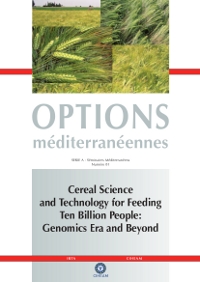| Article précédent | p. 105-109 | Article suivant |
Vrn-H1 and Vrn-H2 allelic diversity in barley may explain specific adaptation to the Mediterranean environments
Some barley genotypes may require prior exposure to low temperature before floral initiation proceeds under inductive photoperiod. The use of molecular techniques led to the identification and positional cloning of vernalization genes in several cereals : VRN-H1 and VRN-H2 in barley. In this study, allelic diversity for those genes was evaluated in a wide sample of genotypes, winter and spring, 2 and 6-row barleys, mainly from the Western Mediterranean region. It included 159 landraces from the Spanish Barley Core Collection and a set of 80 accessions (reference cultivars) mainly from other European countries. Specific alleles for VRN-H1 were found in the Iberian Peninsula, in a higher frequency than that seen in other materials. Allelic diversity matches with flowering time phenotypic responses across several series of field trials and controlled conditions experiments. The phenotypic differences apparently may entail adaptive responses. These results led us to initiate a marker-assisted selection program to introduce the vernalization genes of a Spanish accession into the French winter cultivar Plaisant.
- [ Afficher ]
- [ Télécharger ]
- [ Exporter la citation ]
Vous pouvez télécharger la citation au format :
- [ Imprimer ]
-
Mots-clés
ALLELE, HORDEUM, MARQUEUR GENETIQUE, ORGE, PHENOTYPE, REGION MEDITERRANEENNE, VARIATION GENETIQUE, VERNALISATIONCiter cet article
Casas A.M., Yahiaoui S., Cuesta A., Ciudad F.J., Molina-Cano J.L., Karsai I., Meszaros K., Lasa J.M., Gracia M.P., Hayes P.M., Igartua E., Szûcs P. Vrn-H1 and Vrn-H2 allelic diversity in barley may explain specific adaptation to the Mediterranean environments. In : Molina-Cano J.L. (ed.), Christou P. (ed.), Graner A. (ed.), Hammer K. (ed.), Jouve N. (ed.), Keller B. (ed.), Lasa J.M. (ed.), Powell W. (ed.), Royo C. (ed.), Shewry P. (ed.), Stanca A.M. (ed.). Cereal science and technology for feeding ten billion people: genomics era and beyond. Zaragoza : CIHEAM / IRTA, 2008. p. 105-109. (Options Méditerranéennes : Série A. Séminaires Méditerranéens; n. 81). Meeting of the Eucarpia Cereal Section, 2006/11/13-17, Lleida (Spain). http://om.ciheam.org/om/pdf/a81/00800815.pdf



